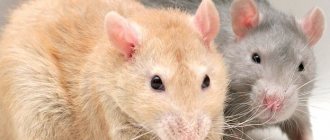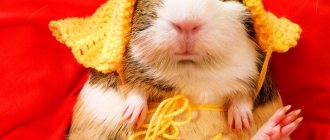- home
- Acquisition
15.04.2018
Many people choose various rodents as pets. This is not surprising, because they take up little space and are easy to care for. Such pets are often given to children, so parents have a question: who is better, a hamster or a rat, should they take a guinea pig or a rabbit. There is no clear answer. Each animal is different from each other in its own way.
Rats or hamsters: choosing a pet for a child
Both rats and hamsters have long topped the lists of the most popular pets for children.
Many parents, when planning to buy an animal, think for a long time - who is better to get, a hamster or a rat? In this article we will look at the advantages and disadvantages of both animals. We hope that we will help you make the right choice! Decorative rats
Pros:
- Rats are less fragile and can be handled without fear. It's no secret that children are often not very careful when touching pets. From this point of view, the rat is an excellent choice. They are stronger than hamsters and weigh about four times as much.
- Rats are less likely to bite. Contrary to popular belief, rats are very gentle creatures and will only bite if they are very scared. All rodents sometimes nip their owners with their teeth, but rats rarely bite people until they bleed.
- Rats are more awake during the day. Most rodents are nocturnal animals, but domestic rats easily adapt to the daily routine of their owners, unlike hamsters.
- Rats are more sociable. Rats are incredibly sociable animals and they really need attention. It is recommended to keep them in pairs: then you can watch your pets play happily with each other. They become attached to their owners and love to sit on their shoulders and arms.
- Rats are very smart: they have, without a doubt, the highest level of intelligence among rodents. That is why they are often used for psychological research. This also means that they are easy to train: they can be trained to defecate in a tray and taught various tricks.
Minuses:
- Rats are predisposed to certain diseases, such as respiratory tract infections and various types of tumors. This means they may need regular visits to the vet, and the associated financial costs.
- Rats are more expensive to keep. Rats need larger cages than hamsters, as well as special bedding, high-quality food and a variety of toys. All this means additional expense items.
- Rats need more attention. It is also necessary to study certain information about their content. Rats spend a lot of time outside the cage, as they are more sociable animals than hamsters - and this means a time investment for the owner.
- Rats should be kept in same-sex pairs or groups: when alone, rats get bored and feel uncomfortable.
Hamsters
Pros:
- They are easy to care for: they require a simple cage and are not fussy eaters. The cage does not need to be cleaned as often as rats do. Hamsters do not need as much attention as rats.
- Hamsters are economical pets. They do not require so many expenses, they do not need special bedding, and food for hamsters is also quite cheap.
- Hamsters don't need a lot of time. Since they are much less social than rats, they do not need to interact with humans often. And thanks to the hamster's modest size, it doesn't need as much exercise as rats, so there's no need to let it out of its cage as often.
- Hamsters can be kept alone: some species are more sociable, but the most common as a pet, the Syrian hamster leads a solitary lifestyle and does not need company.
- Hamsters don't need a lot of space. A hamster's cage may be much less spacious than a rat's cage. Hamsters are not as keen on climbing, so the cages may be lower.
Minuses:
- Hamsters are not that smart. Therefore, you do not get high-quality interaction with them, unlike rats, and they do not become attached to their owners. They are also more difficult to teach anything.
- Hamsters sleep a lot. They are nocturnal animals, so they spend most of the day sleeping. It is more difficult for them to adapt to the rhythm of life of their owners; If you wake them up, they will be in a bad mood and may bite.
- Hamsters make noise at night. As follows from the previous point, hamsters are nocturnal, and can make a lot of noise when running in a wheel, etc. This can be a problem for owners, especially if the child insists on living in the same room as their pet.
- Hamsters do not become attached to their owners.
Conclusions As is clear from the above, rats require more effort and investment, but the return on them is greater. The decision should depend on what you expect from your pet. If you want to teach your child responsibility, a rat is undoubtedly more suitable. But if you want your child to have a cute furry animal, then a hamster will be the best option.
Advantages and disadvantages of keeping pets
All three animals are very touching. It's hard to say who is better and who is worse. Each of them has its own advantages and disadvantages.
Rats
This tailed cutie has significant advantages:
- very smart and inquisitive, easy to train;
- sociable, excellent companion;
- cheerful, you don’t get bored with them;
- low cost of purchase and maintenance;
- easy to care for even a child.
Minuses:
- marks territory with urine;
- the need for frequent cleaning;
- unattractive tail.
The rat is an intelligent animal, it needs not just affection, but communication. The rodent will become a good friend for a school-age child.
Hamster
This furry baby is very popular.
And not in vain, because it has a lot of advantages:
- the cheapest “option” of a rodent;
- does not need communication, can be left alone for a long time;
- clean, almost odorless;
- very active, interesting to watch;
- easy care.
Important! Children under 3 years of age are not recommended to have an animal at all.
While playing with it, the baby can unknowingly cause serious harm to the pet. Its disadvantages:
- very noisy at night;
- bites if handled carelessly;
- climbs through the bars of the cage and into the smallest cracks, does not return to the cage on its own;
- uncommunicative;
- short lifespan.
Although the hamster is very small, it is not suitable for small children. The animal is very fragile, so it is easy to crush. He is not suitable as a companion even for older children, because he does not like to sit in arms and communicate, and he sleeps all day. The fuzzy fidget is a great option for those who like to watch animals rather than hold them in their hands.
We recommend reading accessories for a hamster in a cage.
Rat vs Pig
Rat vs Pig ¶
We had a rat for more than 4 years - a cool animal, but two drawbacks - they don’t live long and there is a problem with the wires. Do not want anymore. We cried for a week when the rat died.
Now we are thinking about a guinea pig.
Who has experience with both rats and pigs, what can you say about comparing intelligence (sociability) and, again, wires and wallpaper?
Rat vs Pig ¶
From: Asya - February 19, 2004 20:34
Both pigs and rats lived and live in my house. A rat and a pig are COMPLETELY different animals, although both are very cute, but not for everyone. A pig requires a more patient approach, proper nutrition and maintenance, and there are more problems with it than with a rat. As a rule, pigs take longer to tame, but if you treat them “humanely,” they become extremely smart. But some people can also chew on wires, but more often pigs peel off wallpaper. In general, if you are ready to treat a pig as a completely different animal than a rat, respect its natural essence and in no case compare it with a rat, then you can try it.
Rat vs Pig ¶
From: Astarta - February 19, 2004 21:16
First of all, I would really like to congratulate you on such a long-lived rat! 4 years is a lot for a rat! The problem with wires can be “treated” easily, try to raise them as high as possible so that the rat’s teeth do not reach, and wrap those parts of the wire that cannot be lifted with electrical tape - this way they are much less attractive to the tailed one. I have 5 rats on “free grazing” - so Let's save ourselves I do not agree that pigs require more careful maintenance. This is fundamentally wrong. Any animal should receive maximum attention and care. Wires and wallpaper are gnawed by both, although whichever animal comes across may not gnaw. 3 out of 5 of my rats are not interested in wires (they like the plinth more))) Regarding intelligence. Now many people will probably swear at me, but still. My pig lived for 4 years and during that time there were always rats in the house. According to my observations, rats are much smarter animals, they are more sociable. Maybe I came across such a stupid pig (don’t think about it, I loved him very much and did everything in my power to save the animal), maybe I did something wrong, but Aryan led a very “vegetative” existence: he ate and slept (well, he whistled when there was food) wanted). It seemed to me that rats are more loyal animals than pigs. Having a rat, you are used to the animal constantly running around, playing with your hand, trying to kiss you, but this is not the case with a pig. She is cute in her own way and purrs very funny. I don’t want to dissuade you from mumps, they’re just different. Remember how much joy the little rat brought you. Isn't this a reason to bring this joy back into the home? You will make another animal happy! And everyone dies. and rats and pigs. [ 19 February 2004, 22:51: Message changed: Squirrel ]
Comparison of intelligence
There is a very good reason why rats have a high survival rate in the wild - their superior intelligence. Rats are among the most intelligent creatures of their size, capable of quickly solving seemingly complex problems.
For pets, this intelligence can be a good thing. Many pet rats are capable of learning tricks and can also recognize different family members. This can make them very attractive as pets.
The downside to this intelligence is that great care must be taken to ensure proper brain activity for them at all times. Not only should rats get out of their cage regularly to interact with people, but it is also important that they have adequate space and a range of toys to entertain themselves with.
Also note that it is recommended to keep two or more rats together so that they always have company.
Although toys are available for hamsters, they tend to be less interested in them. Sometimes a hamster can use a simple wheel, no matter how much money you have invested in expensive toys.
Ideal pet rodent: guinea pig or hamster?
Guinea pig and hamster are interesting and inquisitive animals. Both pets will definitely bring joy and fun to your home and will not let you get bored. The choice of a pet depends entirely on you: on your financial capabilities, on the available time for care, on the “requirements” for the pet, etc. Below you can get acquainted with the characteristics of each animal and the fundamental differences between them, which will help you make the right decision.
Guinea pigs are very friendly, while hamsters have an independent character
What should be in a Djungarian hamster's cage?
Charming dzungariks attract attention even in the store. Of all the hamster breeds, they are the most popular and interesting.
These curious and mobile creatures can constantly move around their territory, arrange it and stock up. You need to understand that for each type of rodent, it is necessary to create its own conditions for their comfortable existence. It’s great if the Djungarian hamster has a multi-tiered home. All kinds of stairs and passages, tunnels, grottoes and bridges will create not only a pleasant picture for the observer, but will also become excellent exercise equipment for the furry guest. What must be in a dwarf's cage is a running wheel. Physical exercise will help avoid obesity and strengthen your psyche.
When choosing accessories for your Djungarian hamster's cage, you can also prepare a chalk stone on which he will sharpen his teeth, and equip a sandbox with sand - this is where he will clean his fur coat.
It wouldn’t hurt to buy or make a labyrinth or tunnel with your own hands from scrap materials.
It is important to remember that they must have ventilation holes, otherwise the rodent may have difficulty breathing over long areas.
Djungarian hamster cage
The sand in the sandbox must be changed at least once every 3 days, otherwise the hamsters will turn the bathtub into a toilet.
Who is better: a guinea pig or a hamster - the pros and cons of animals
Both animals - a guinea pig and a hamster - are playful and nimble animals that can create a cheerful and cozy atmosphere in the house. To make a choice, you should take into account the pet’s temperament, as well as the characteristics of care and maintenance.
What's good about a guinea pig?
Guinea pigs are easy to care for and maintain, as well as quick adaptation. The main advantages of these animals include:
- unpretentiousness in keeping and ease of caring for the pet (the main thing is to feed the animal and clean its cage);
- training opportunity;
- absolute absence of aggression ( pigs never bite or scratch their owners . By nature they are quite cowardly animals, so even for the purpose of self-defense they will not show aggression, but will try to squeeze themselves into a ball and hide);
getting along with other pets (pigs are very friendly, they quickly find contact with both other rodents and larger pets: cats, dogs)
- the possibility of keeping guinea pigs in same-sex pairs ( these fluffies are not inclined to show aggression towards their brothers, they do not have the instinct to fight for a cage or leadership , so two females or two males will get along well in one cage);
- love of affection and tenderness (these furry animals simply adore being stroked and scratched; they express their pleasure with the help of various touching sounds);
- talkativeness ( you simply cannot forget that your pet needs to be fed. A vocal pig will definitely remind you of itself with various interesting sounds when it wants to eat).
Who better to have at home
To choose the right pet, it is recommended to consider not only the pros and cons of animals. You also need to think about what is best for the owner. If you need a smart, affectionate and sociable friend, get a rat. For those who like to watch the funny fuss of furry babies, a hamster is suitable.
In any case, soon the small animals will become part of the family, and their shortcomings will fade into the background.
All of the above pros and cons are conditional and are, rather, part of a subjective assessment. In fact, it is impossible to say exactly which animal is better. You can only determine who is more suitable by character.
Hamsters may still be considered the "standard" pet rodent, but rats have gained many fans over the years. Many rat owners claim that their chosen pet has a lot of advantages - if you don't pay attention to the tail. They're smart, clean and playful, but when it comes to rats versus hamsters, who really wins the battle?
What is the difference between a hamster and a guinea pig?
Despite belonging to the same order and almost equally popular for home breeding, these animals have a number of fundamental differences:
- size is the first difference that immediately catches your eye. Compared even to the Syrian hamster (the largest breed of domestic hamster), the guinea pig looks much larger ;
- lifestyle is the most important difference and often plays a decisive role when choosing a pet. The fact is that hamsters are nocturnal inhabitants, so you can only observe their active period of life in the late evening or at night, since small rodents sleep most of the day. Guinea pigs are more active during the day and rest at night . This is not to say that pigs sleep all night. Their sleeping style is very interesting - due to their increased fearfulness, pigs sleep for 10-15 minutes several times a day;
Nutrition - there is a difference both in the amount of food consumed and in the diet itself. A hamster needs much less food than a pig. You should feed him once a day, in the late afternoon, and regularly pamper him with cheese, lettuce leaves, meat or slices of bananas. Unlike hamsters, guinea pigs should not be given meat, cheese or potatoes. The pig should be given food 2 times a day - morning and evening. The main delicacy for pigs is fresh cucumber, sweet pepper and apple. A general rule for both rodents: there should be branches of fruit trees in the cage so that the pets can grind down their teeth
- life expectancy - rodents have a significant difference in this criterion. Guinea pigs live much longer: their average lifespan with proper care is 5-7 years. Hamsters rarely live past three years;
- learning ability - in this case, guinea pigs have an advantage. These animals are easy to train, so if desired, pigs can be trained to perform tricks of varying degrees of complexity. A trained pig can recognize its owner, follow him, roll a small ball with its muzzle, and also stand on its hind legs ;
- home - the difference is in the size of the cage, as well as its contents. A guinea pig needs a spacious cage in which it can lead an active lifestyle, since inactivity often leads to obesity. The cage should have a house or hammock in which the pig can sleep or hide. It is not necessary for a hamster to purchase a spacious cage; the main condition is the presence of various labyrinths and a running wheel in the cage. Like a guinea pig, a hamster needs a place to sleep and hide. It is important that the hamster’s house needs to be cleaned regularly, because this thrifty animal tends to carry and hide food that can quickly spoil;
- walk: you should not let your hamster out for a walk around the house - he will definitely be attracted to some hard-to-reach place that will vaguely remind him of a hole. Getting the baby out of there will be a real challenge, so you need to let the hamster go for a walk only in a special ball, which can be purchased at a pet store. With a guinea pig, things are much simpler - you can and even need to let him go for a walk . Catching it will not be difficult due to its large size and slowness.
Children under 3 years old should not have a pet at all.
Making a choice
Land animals are almost identical in the basic rules of care and nutrition. The difference is found only in character and abilities. The guinea pig is a fairly intelligent rodent that is easy to train. With a hamster it will be more difficult in this regard. Another important point in how a hamster differs from a guinea pig is that the pig lives longer. With good care, she can live up to 6 years, while hamsters begin to age at the age of 1 year, and at the turn of 2-3 years the animal dies.
It is common for all children to want to have a pet with whom they can play or watch the antics of the animal, having fun in its company. If your baby likes to cuddle animals, the guinea pig will be very happy to have an affectionate owner. Hamsters prefer peace and freedom, so school-age children will be an ideal owner for them.
Should I buy a guinea pig or a hamster for my child?
These pet rodents are living sources of fun and happiness for both adults and children. If you want to get a pet for a child, you need to take into account the age and character of the future owner.
It is better for children under three years old not to have pets at all, because this is not yet the most conscious age of a child, let the kids grow up a little.
Guinea pigs are perfect for children aged three years and older. These pets get along well with children and are friendly and playful. The absolute absence of aggression is also important to consider, because young children do not always know the limits and limits when playing with pets, to which a hamster, for example, can respond with a sharp bite. But older children can already choose a hamster as a pet. He will become a good friend for schoolchildren.
Degu
Degus are rare domestic rodents, very active, cute, easily tamed animals. This rodent, like a chinchilla, needs a spacious cage with a house, a drinking bowl, a wheel and other toys for active games. A degu should always have specialized food in its feeder consisting of herbs, cereals and vegetables, as well as hay and branches for grinding down teeth. But sweet fruits and dried fruits are contraindicated for these rodents due to their predisposition to diabetes.
Degus are very sociable and get used to the hands of their owner and can recognize him by smell. This pet is a social animal, so it requires constant communication either with other degus or with its owner. Therefore, if you do not have enough time for your pet, buy him a pair.
Who are these “neighbors” suitable for?
Various signs about hamsters relate primarily to their practicality.
A pet can be an excellent talisman for a person with his head in the clouds
Of course, we are not talking about complete carelessness, which can threaten the life of a rodent. Rumor advises purchasing hamsters for those who cannot decide on their priorities, often change their beliefs, and have difficulty getting along with others. A living amulet will help you find your inner core and concentrate on achieving a truly important goal.
Hamster in a dream
A dream in which you saw a healthy hamster with stuffed cheeks promises financial profit. If the rodent is fussing, rushing about, fleeing from you, you should think about the correctness of the chosen course of life
It is possible that for future success it is necessary to temporarily “tighten the belt”, show caution, accuracy and frugality.. ← Previous article
← Previous article
Next article →
What to do if a cat bites a hamster
There are often cases when the owner manages to notice a commotion in the apartment in time and removes the hamster from the paws of the cat. If the rodent is lucky enough to remain unharmed, but is not without a bite, it is necessary to treat the wound with an antiseptic and immediately take the pet to the veterinarian. Primary treatment will help disinfect the open wound, but you should not continue self-medication, since the consequences may be irreversible.
After an unpleasant meeting, try to create the most calm conditions for your pet’s life. The resulting stress can result in anxiety in your hamster, regardless of its breed. The Syrian hamster is larger than the Djungarian hamster, giving the impression of a stronger and more resilient fighter. But in a practical sense, each of them is equally worried and nervous. When taking care of the rodent, any possible contact between the cat and the hamster must be completely excluded.
The opposite situation also happens, when a hamster bites a cat. Then the question arises, can a hamster infect a cat and what diseases can be transmitted from an infected hamster? You can learn about this from the article about why a hamster is dangerous and how to choose the right hamster to prevent illness.











